Home Safety Checklist
Being safe in your home should be your largest concern. But are you missing one or two useful safety items? Look over this home safety checklist and see where your house requires some work.
This guide begins with five whole-house safety items, and then we whittle it down to specific room ideas. Then, call 833-319-7449 or send in the form below to get your home safe and secure.
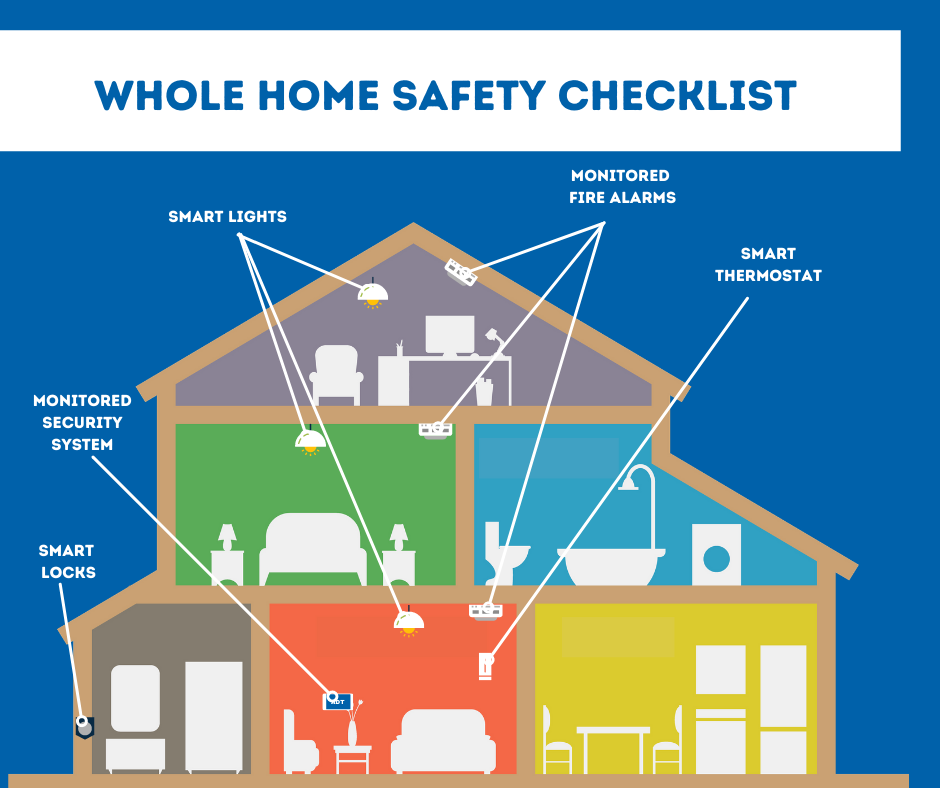
Essential Home Safety Checklist
While you may want to employ an individual room process for home safety, there are some methods that are practical for the whole house. These devices can talk together through a wireless hub, and can even work off other components. You might also control each of your home safety components using a smartphone app, such as ADT Control:
-
Monitored Home Security System: All your windows and doors should employ a sensor that alerts you to forced entry. When an alarm goes off, your monitoring agent responds to the alert and immediately calls emergency personnel.
-
Smart Lighting For Every Major Room: Sure, you can set your smart lights to become more eco-conscience. But they can also allow you to keep safe in an emergency. Have your downstairs lights flash on when an alarm goes off to shoo off robbers or illuminate the way out to an outside area.
-
Smart Thermostat: Like your smart lights, a smart thermostat could save you between 10%-15% in utility costs. But it also can turn on your exhaust fan if you have a fire.
-
Monitored Smoke Detectors: It’s code that you have a smoke detector on each level. You can improve your fire preparedness by installing a monitored fire alarm that senses excessive heat and smoke, and notifies your 24/7 monitoring team when it thinks that there’s a fire.
-
Smart Door Locks: Every door that needs a keyed lock can use a smart lock. Now you can program key codes to family and friends and receive alerts to your mobile device when the locks are used. Your doors can even automatically turn off, letting you quickly get out if you have an emergency.
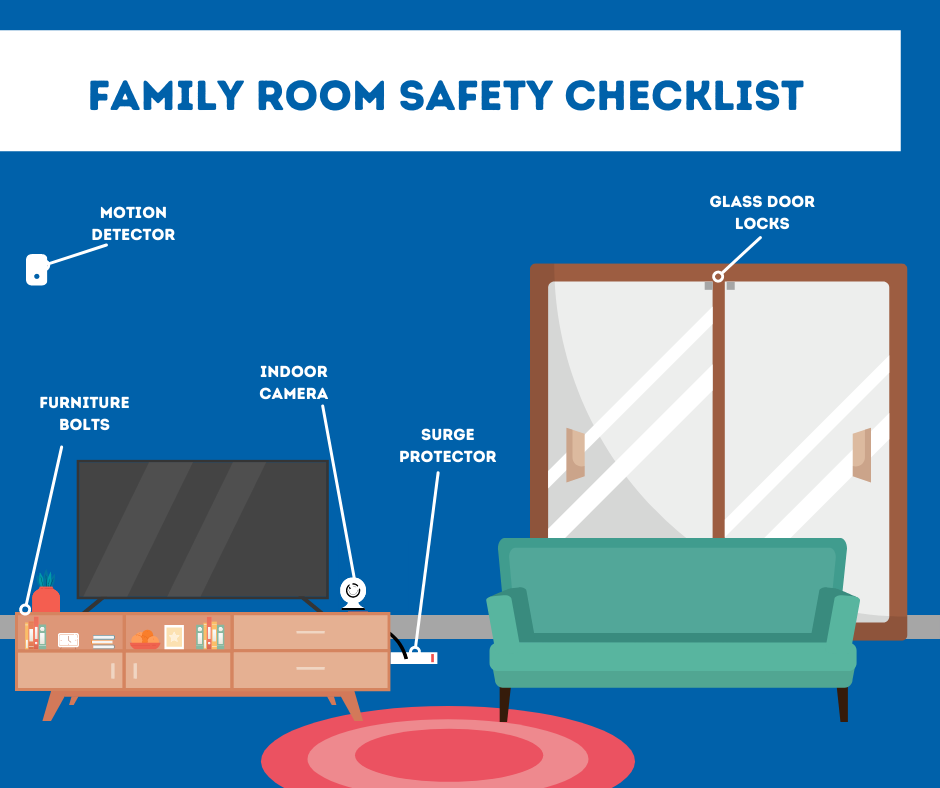
Family Room/Living Room Safety Checklist
You’ll spend a lot of time in the living room, so it may be the most reasonable place to start making your home safer. Highly sought-after items, like your TV or video games, usually are located in your family room, making it a popular space for robbers. Start with placing a motion detector or security camera by the doorway, then continue on with some of these suggestions:
-
Motion Sensors: By putting in motion detectors, you’ll get a shrieking siren anytime they detect unusual movement within your family room. Look for motion sensors that filter out a dog or cat or you’ll get an alert each time your pet comes in for a midnight stroll.
-
Indoor Camera: An indoor security camera offers a visual of your living room. Get live streams of everything so you can know what’s happening from the mobile app. Or speak with your kids when they arrive home from playing with the two-way talk feature.
-
Surge Protector/Outlet Maintenance: Make sure you protect all your electronics and stop overtaxing your electric system with a surge protector. For additional energy-efficiency, use a smart plug with surge protection built-in.
-
Entertainment Center Attached To The Wall: If you have babies or toddlers, you’ll need to secure your entertainment center or other heavy furniture to the wall. This is extra crucial if your living room uses carpeting that might make furniture extra unstable.
-
Special Locks For Sliding Glass Doors: If your family room uses a sliding glass door that slides out to a deck, patio, or outside porch, you already can see that the door lock is fairly thin. Use an enhanced lock, like a bottom bar or locks that are located on the top and bottom of the frame.
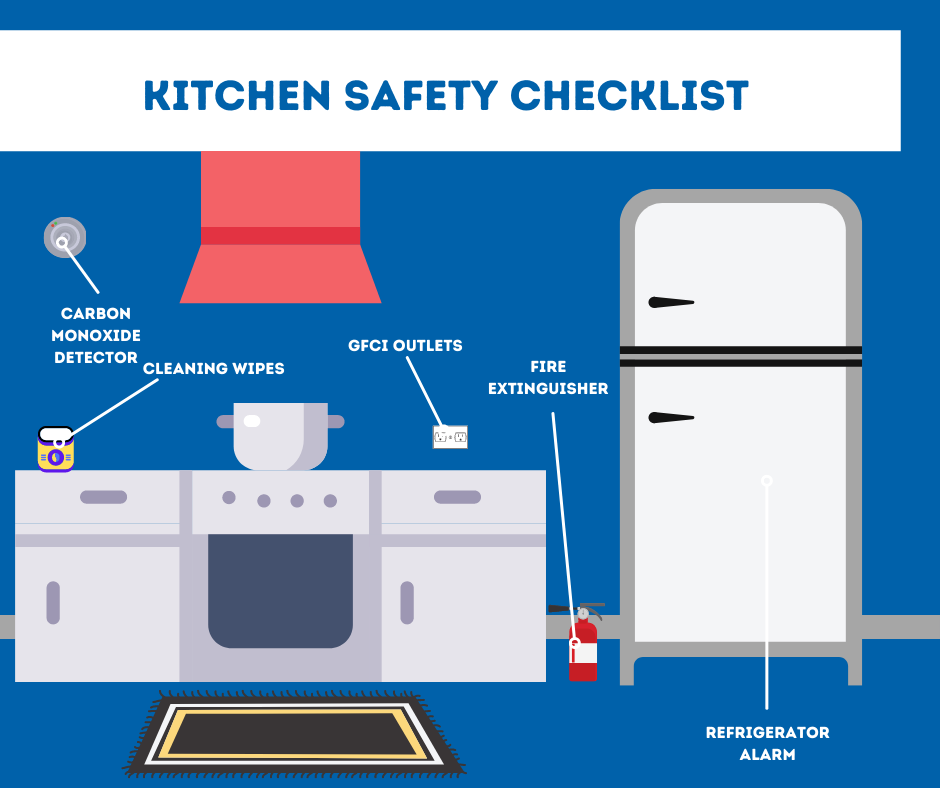
Kitchen Safety Checklist
The kitchen has many items that should bring safety to your home. Most of these objects should be simple to add and can be purchased from a retail store:
-
Fire Extinguisher: Fire can happen from an overfilled skillet or a faulty burner. Always keep a fire extinguisher at hand for any cooking mishaps.
-
Circuit Interrupter Box On Every Outlet: A circuit interrupter outlet should be standard anywhere there’s nearby running water to prevent a deadly shock. That includes the plugs close to your sink and kitchen counter. Since the late ‘80s, it’s been required to have one circuit interrupter outlet per dedicated circuit. But each one of your plugs will go dead if one outlet detects a surge, so you’ll want to use an unchained GFCI for every outlet.
-
Monitored CO Detector: A CO detector is recommended for the kitchen if you use natural gas for the oven and stove. If your gas appliances malfunction, the carbon monoxide detector will play a high-decibel siren and ping your monitoring professional.
-
Clorox Wipes Or Spray: The most overlooked safety hazard in the kitchen is the invisible bacteria and protein that comes with raw meat and dairy. Always store disinfectant wipes or an antibacterial spray to clean your surfaces when cooking.
-
Freezer and Refrigerator Alarm: The milk, meat, and perishables in the refrigerator need to remain at a chilly temperature to stay healthy to use. If you accidentally leave the freezer or refrigerator door open, then a constant beep will let you know so you can close the door. Some refrigerators already have a pre-installed alarm, others won’t, and you’ll have to buy a fridge alarm online.
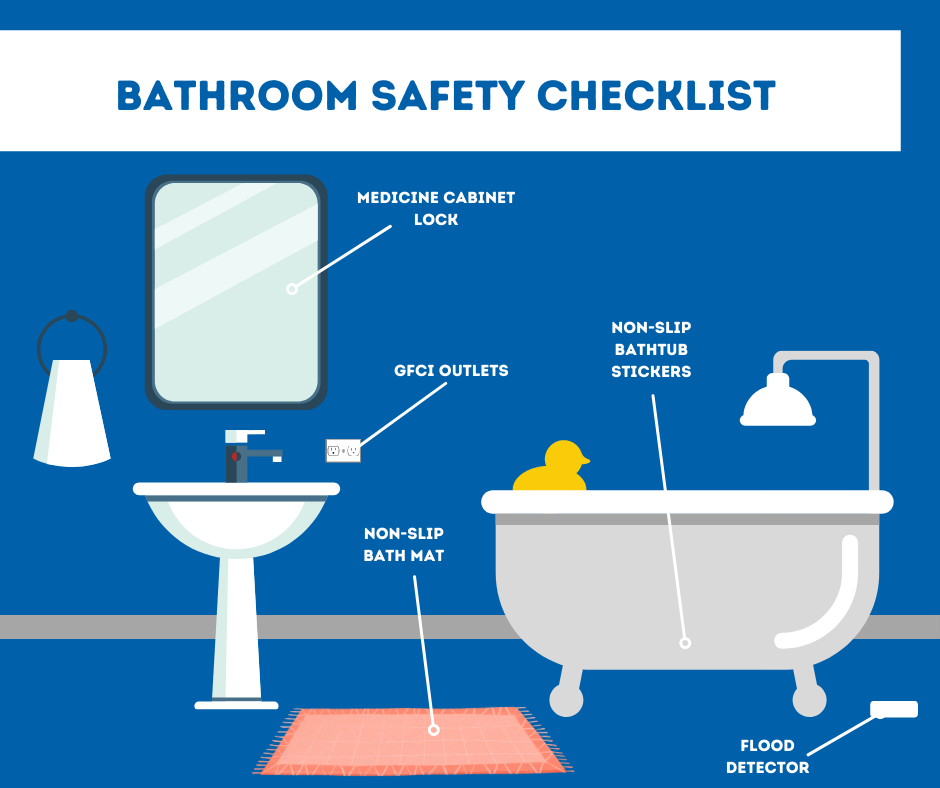
Bathroom Safety Checklist
Just because there’s not a bunch of space in your bathroom doesn’t mean that there aren’t safety hazards. From flood detectors to medicine care, here are some safety tips for your bathroom:
-
Flood Sensors: A leaking sink or tub can cause an expensive amount of water damage. Find out early about pooling water with a flood detector and save hundreds to thousands of dollars from water damage.
-
No-slip Bath Mats: A slip in the bathroom can be a painful occurrence, causing pulled muscles, sore joints, or broken bones. You can prevent these issues with a textured bathroom mat for after your bath or shower.
-
Textured Bathtub Strips: Likewise, a bathtub can be a slippery place to be on. It’s a good idea that every tub has some no-slip strips so your feet have a bumpy patch to grip.
-
Medicine Door Lock: If you have young toddlers or a family member with memory difficulties, you should take additional precautions regarding prescribed medicine. Hideaway your prescriptions by installing a medicine cabinet with a child-proof lock.
-
Circuit Interrupter Outlet: While installing better outlets in the kitchen, you need to also put in a grounded circuit interrupter outlet on each bathroom outlet. This will shut off the current if they ever get wet or you have a harmful surge from a curling iron or hairdryer.
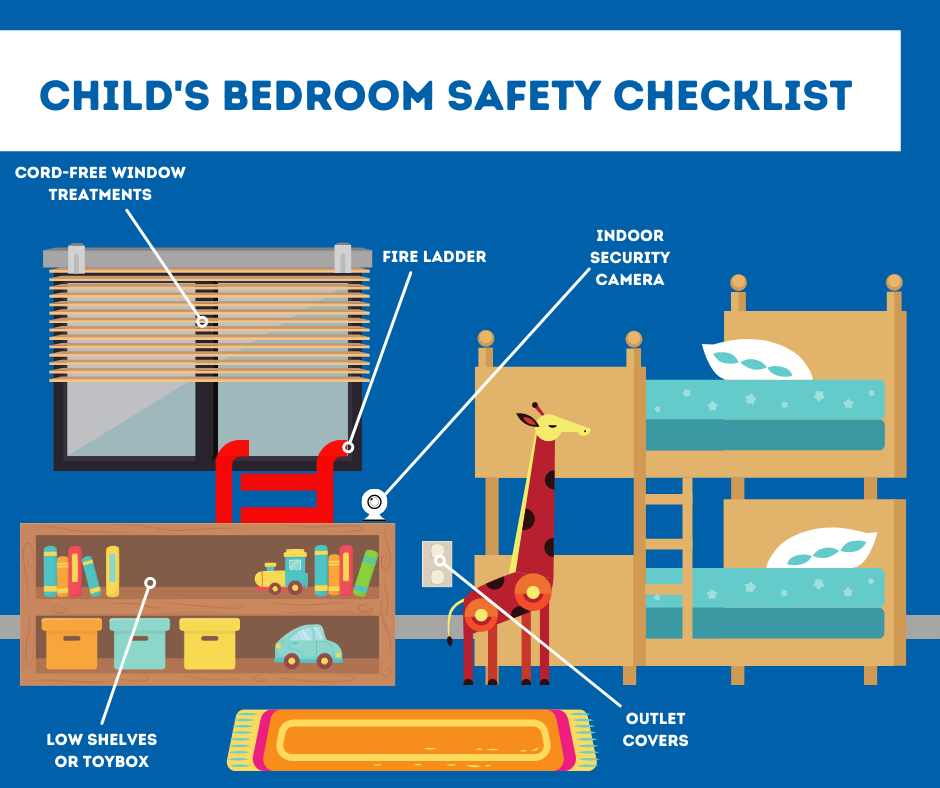
Children’s Bedroom Safety Checklist
Your kid’s bedroom should pair safety with simplicity. If their window shades or other items are safe but hard to operate, then your children may perform dangerous activities -- like climbing a chest of drawers -- to use them. Here are 5 easy, yet safe, ideas:
-
Cordless Window Treatments: Safety agencies have designated corded window treatments as a hidden problem for kids and pets. Install motorized blinds or shades that you can easily manage with a remote control. Or better yet, pair your motorized treatments to your ADT security system so they can raise without anyone’s help when it’s time to get up and lower at night for a night of easier sleep.
-
Indoor Security Camera: A security camera placed on your child’s desk can double as a baby monitor that you can view from a mobile device. And when they need your help, they can hit the two-way talk feature included on the camera.
-
Outlet Plug Covers: While every outlet should use covers on them to protect your small children, this is especially urgent in a child’s bedroom. It’s the one room in your house where your children will most likely play by themselves without adult supervision.
-
Window Fire Ladder: If you use bedrooms on an upper floor, then you will want to put in a window fire ladder. These should help your children escape when the stairs or downstairs are blocked off by a fire. Just remember to go over how to use them a few times a year.
-
Toy Box Or Low Bookshelves: It’s weird to view a toy box as a safety item, but you’ll understand if you’ve ever tramped on a Lego in your stocking feet. A clutter-free floor gives your child a quick way out when there’s a safety or security event.
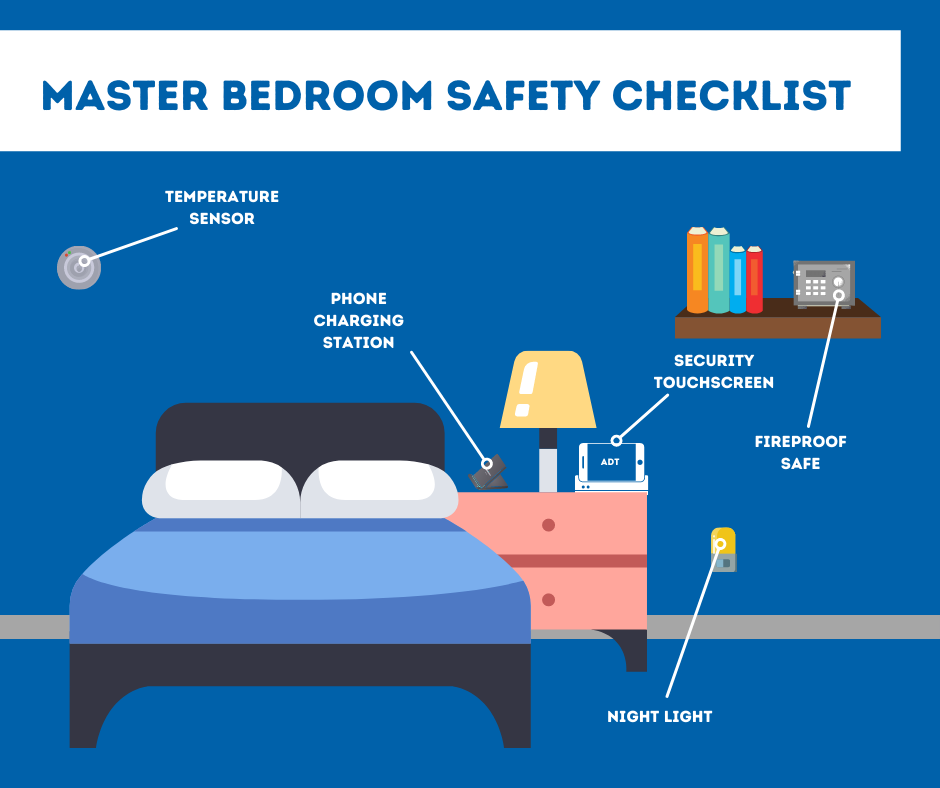
Master Bedroom Safety Checklist
The main bedroom should be your calm space, so let your safety components give you peace of mind when you experience an emergency event. After all, being startled awake by a loud alarm can be confusing.
-
Security System Touchscreen: Having a smart hub on your bedside table helps you know what’s going on without leaving your bed. You could alternatively log into your ADT mobile app. However, the touchscreen can be better to use when you’re coming out of sleep and confused.
-
Device Charging Station: We use our phones for almost everything now alarm clocks, internet searches, social media, and sometimes even phones. But, a dead phone in the middle of the night cuts us off from communications if during an emergency. To keep it nice and ready, a charging station or cord is essential.
-
Smart Lights Or Nightlights: A plug-in light helps ground you when you’re startled awake from a siren or other loud noises. If you won’t drift off to sleep with a small nightlight, use a smart bulb in your bedroom and hall. Then you can get light anytime with a push of a button or voice direction.
-
Fireproof Lockbox: Store your essential paperwork like birth certificates, stock certificates, or a bankbook in a fireproof safe. Your safe can be a big one that camps out in your closet or a small handheld lockbox that you can carry as you escape during a fire or break-in.
-
Heat Sensor: The drawback with a master bedroom is that they might run too stuffy or be frigid because they are far from the thermostat. A temperature sensor can communicate to your smart thermostat so you will have a comfortable, peaceful sleep at just the right climate.

Basement/Garage Safety Checklist
Most safety needs in the garage or basement deal with your pipes or furnace. Finding issues before they start can prevent larger problems later on. So, as you look around your storage areas, take note of these crucial items:
-
Flood Sensor Or Sump Pump Alarm: Installing a flood alarm next to your water heater or sump pump can prevent you from finding a lake when you walk into your garage or basement. It’s definitely better than rummaging through a bunch of soggy storage boxes.
-
CO Detector: It’s beneficial to have a CO detector in an area where a gas leak can spring up. If you employ gas heating, try to put an alarm in the same room as your unit.
-
WiFi Water Shutoff Valve: If your water detector senses a plumbing leak or a busted pipe, then you need to cut off the primary water line immediately. With a wireless shutoff valve, you can block water flow from any mobile device. That’s nice when you’re visiting relatives and get a flood sensor alert on your mobile device.
-
Garage Door Sensor: Leaving the garage open brings about all types of issues. You can waste HVAC energy through that large opening, and critters or lurkers can just wander in. A remote sensor will notify you about a forgotten garage door and allow you to close it remotely.
-
Temperature Sensor: A heat sensor in your garage or basement is essential if you worry about freezing pipes. The temperature in these rooms can be drastically different than your main rooms of the house, so you will need to keep a close look at the temp through the ADT mobile app.
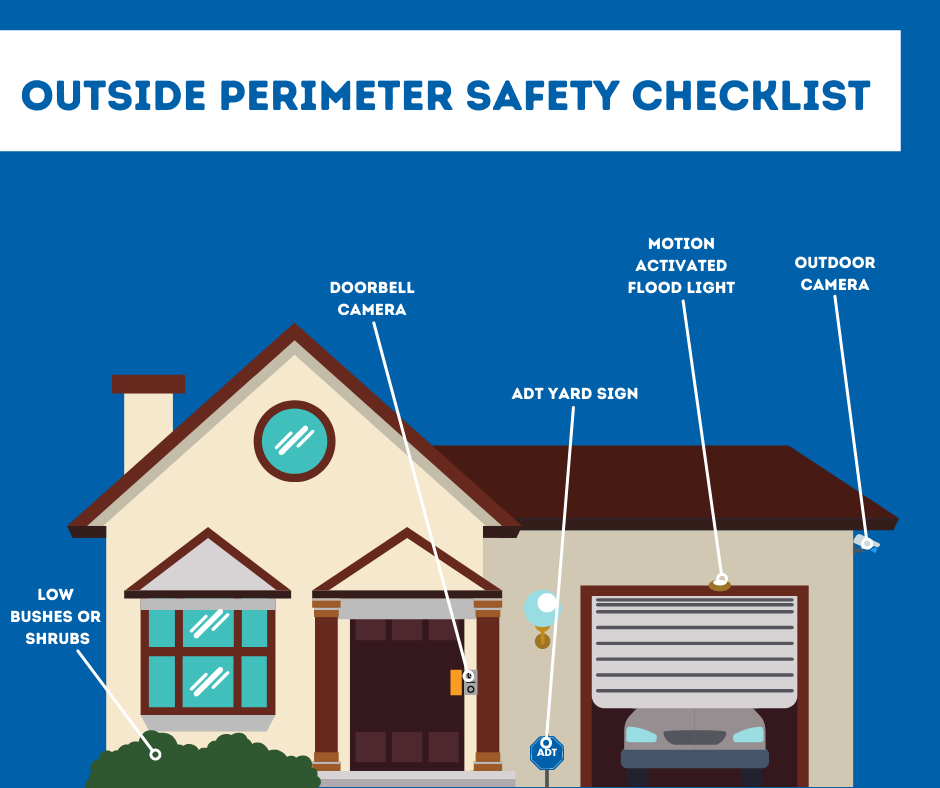
Home Perimeter Safety Checklist
Your landscaping, driveway, and front walk are just as important to defend as the interior of your home. Use this checklist to make your outside safe:
-
Doorbell Camera: See who’s at the front step before you open it and talk to guests. View deliveries and review video clips if they vanish off the step.
-
Outdoor Camera: You can place outdoor cameras to guard against suspicious movement in your backyard. These security cameras come in handy in places where you may not have a window installed -- like around a cellar or by the driveway.
-
Window Height Bushes: Overgrown foliage can create some solitude, but they also block you from seeing into the yard. Don’t give potential burglars an area to hide. Plus, tall bushes, shrubs, or greenery too close to your structure can clog gutters and summon ants and termites.
-
ADT Signs And Decals: One of the most popular discouragements for a break-in is advertising to would-be intruders that you own an updated ADT security system. An ADT yard sign by the stoop and a window sticker will tell people that they should shove off to an unprotected house.
-
Motion Activated Porch Light Fixtures: Light is the biggest obstacle to those who lurk in the shadows. Motion-activated lights on your deck, patio, or garage can frighten lurkers away. They also help you work the locks when you come to the house on those dark, winter nights.
Contact Secure24 Alarm Systems To Help You Finish Your Home Safety Checklist
While Secure24 Alarm Systems can’t install every item on your home safety checklist, we can discuss a state-of-the-art home security system. With easy-to-use devices and ADT monitoring, we can personalize the ideal system for your family’s needs. Just contact 833-319-7449 for more information or send in the form below. Or customize your own system with our Security System Designer.
